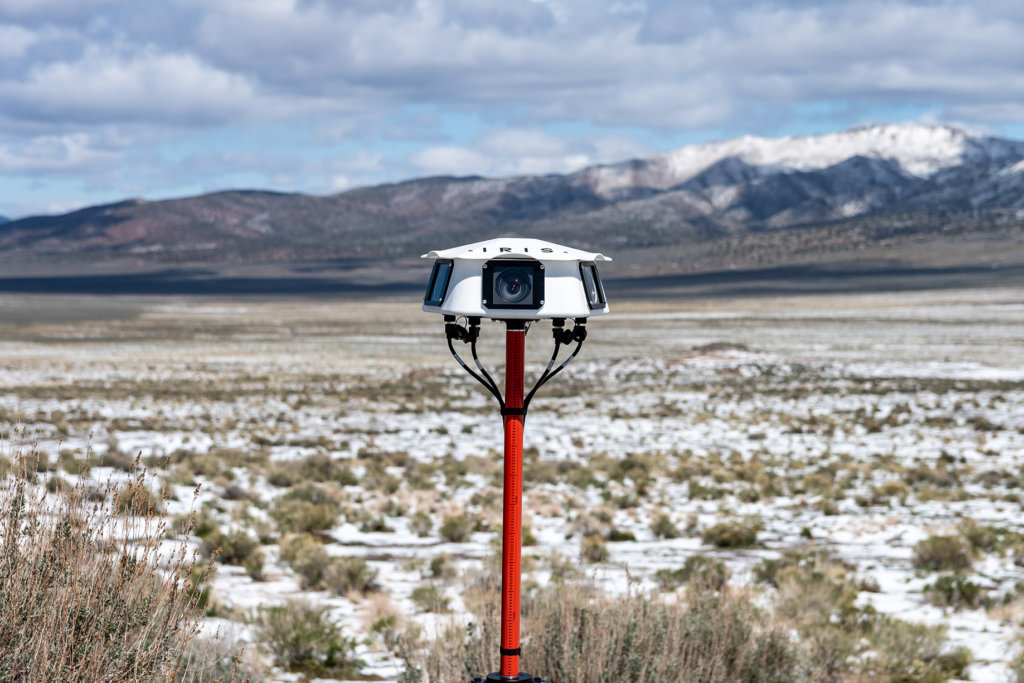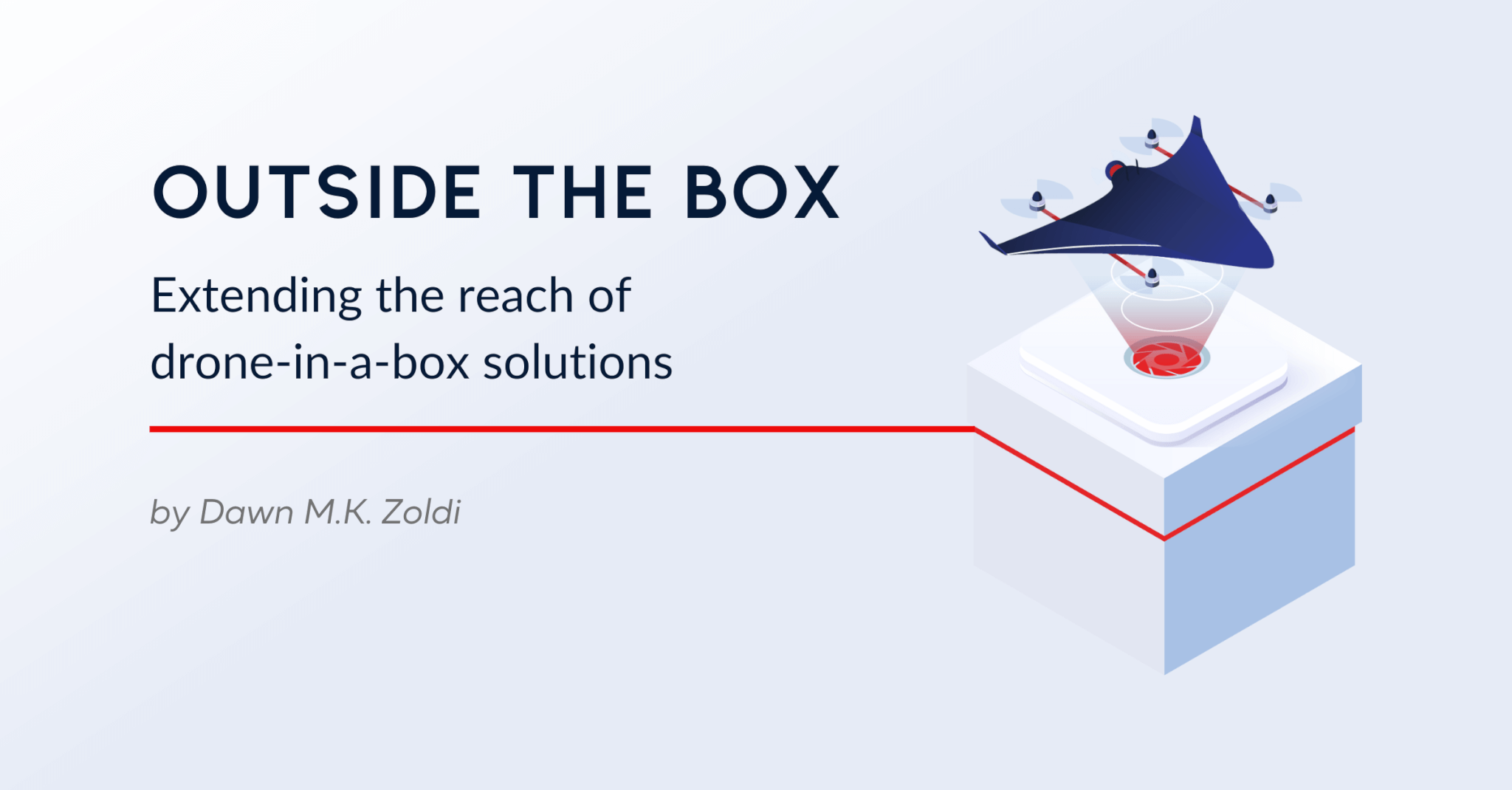By: Dawn M.K. Zoldi*
Drone-in-a-box (DIB) solutions, an innovative means for autonomous uncrewed aerial vehicle (UAVs) to launch from and return to highly sophisticated, self-contained and networked landing boxes, have improved safety, efficiency and quality of data collection and analysis across numerous market sectors. These systems enable, among other things, beyond visual line of sight operations (BVLOS) across varying distances. But for many companies, distance matters. Augmenting DIB options with strategically placed ground-based surveillance system (GBSS) nodes can limitlessly extend and protect operating areas.
Better, Faster, Safer
Traditional drones require a pilot to use a ground-based controller and keep the UAV within visual line of sight. Operators of DIB systems remotely launch the UAV from a command center, prepositioned at an onsite location, to execute a pre-programmed sequence. The UAV then returns to base to charge and/or upload information.
This DIB concept has provided companies with the ability to stage equipment in work areas and automate workflows from end-to-end with large quantities of high-quality data in a manner that exceeds manual or partially automated inspections.
The main challenges with manual or partially automated inspections include:
- Data collection – difficulties in scheduling, frequency, cost and safety
- Comparing new data to historical data – the ability to look at an image of an asset and compare it to previous images of that same asset is difficult. This is largely due to big data challenges such as data storage and organization.
- Data analysis – manual data analysis relies on employees looking at visual data and trying to detect faults or changes. At best, this isn’t scalable, and employees are likely to miss minute faults.
- Lack of organizational access to the data – Sharing data across multiple stakeholders is challenging – with a simple email, a lot of insights get lost or missed, and there often isn’t a common language used to get the severity across or even clearly explain the insight.
With regards to data collection and safety, having an UAV or robot do something alleviates the need to send employees into harm’s way. For example, BNSF deployed a UAV during unprecedented flooding in the Midwest that caused railway service interruptions. Instead of deploying personnel, to walk up and down the impacted track to first assess the damage to develop a recovery plan, the UAV flew 2-mile reconnaissance flights overhead. Not only did this result in large quantities of data, it also kept the team safe.
For data analysis, drones can provide high resolution imaging and thermal imaging to clearly show any anomalies in a report. DIB systems provide real time access to data and insights to anyone in the organization, from any location. That same information will be available for posterity, to go back and rewatch the missions. Data gathered can be automatically sent in reports and easily shared.
The DIB solution gets people connected to the important information to enable informed decisions that keep people safe. As a result, many industries have started incorporating DIB technology into their processes for security, surveying, modeling, inspections and more.
Unparalleled Sector Support
In the United States, drones have increasingly become a key tool to support legally-required inspections for the systems and assets that comprise the 16 sectors of critical infrastructure (see here). DIB solutions have upped the ante in these operations.
In the food and agriculture sector, DIB solutions allow for consistently scheduled crop monitoring. Easy Aerial’s DIB, which comes in tethered, free-flight (untethered) and the industry’s first tethered/free-flight hybrid configurations, can launch and recover from moving platforms, including tractors or trucks. According to Easy Aerial CEO Ido Gur, the value proposition is clear. “Given the mandate of increasing the precision and sustainability within the agricultural vertical, DIB solutions play a big part in enabling the air and ground solution of real-time data automation that is necessary to revolutionize and drive down the costs associated with manpower, heavy manual equipment, pesticides, and fertilizers,” Gur said. “DIB allows a farmer to focus on maximizing crop yields to get their goods to market, while also increasing safety and lowering environmental effects. DIB has the potential to increase ROI at least 10-fold over current manual operations.” (Learn more about Easy Aerial’s EasyAG here).
Poland’s Dronehub DIB kit assists numerous sectors by providing autonomous drone security assessments for commercial venues and events. An outlier, this company advertises a UAV flight range of up to 22 miles (35km) on a single charge, the company reportedly is the first European system providing automatic and under-two-minutes battery replacement.
Similarly, DIB has changed the way of doing business in energy, including mining companies. Israel-based Percepto has transformed site asset inspections for ICL Dead Sea, a leading global manufacturer of potash and other minerals, with its Percepto AIM. The first enterprise solution to inspect, manage and secure sites, AIM employs on-site autonomous drones to collect data, provide real time visual data management and analysis, and simultaneously generate business reports and digital twins. According to Dor Abuhasira, Percepto CEO, autonomous inspections of Dead Sea’s electric grid, pipes, pools and piles has boosted Dead Sea’s productivity allowing them to run daily inspections of their infrastructure, in addition to bolstering security and ensuring environmental compliance.
DIB has also transformed the railway industry, through regularized maintenance, safety hazard prevention and rapid first response. Part of the transportation sector, railway companies must ensure traffic remains uninterrupted. Since 2015, BNSF, for example, has regularly conducted extensive track, bridge, rail and weather event inspections across its network to meet federal requirements.
These are but a few examples as to how DIB solutions have improved asset management and support. But what if we could safely extend the drone’s operational range while maintaining autonomy?

Out of the Box DIB Extension
DIB solutions, by definition, fly BVLOS. This requires airspace awareness. Recognizing this, regulators and standards bodies such as the Radio Technical Commission for Aeronautics (RTCA) and ASTM International (ASTM) have included GBSS as one of the key enablers for extended operations.
Iris Automation recently launched its own GBSS, Casia G, to detect approaching aircraft as they approach DIB-connected UAVs. It leverages the same artificial intelligence and computer vision technology as the company’s Casia® series of onboard integrated systems.
Casia is an electro optical system that incorporates machine vision cameras, a processing unit, and deep learning algorithms. It is compact and light enough to be installed onto aircraft as small as a drone. Casia onboard provides pilots with onboard processing power and a powerful computer vision system.
In 2021, Iris released a multi-camera version of its onboard system, called the Casia X. Incorporating up to six cameras, Casia X provides operators with a 360 degree field of regard for a full awareness of potential collision threats.
Casia onboard systems take advantage of being directly connected to the autopilot, removing the human from the decision loop, which creates more time budget for the avoidance maneuver.
Casia G provides this same robust situational information and intelligent decision-making in real time to avoid mid-air collisions, but fixed from the ground.
Casia G can be set up to cover large areas while securing the airspace from aircraft collisions in place of human visual observers. Daisy-chaining Casia G nodes around a work area perimeter could provide a perimeter of sanitized airspace enabling UAS to safely operate missions at scale. By combining this GBSS with DIB networks and other onboard DAA systems, this integrated mesh network would constantly monitor the airspace around a perimeter to detect potential mid-air collisions, alert the pilots in command of risk, and permit the pilot (or system if human is out of the loop) to safely maneuver out of the potential intruder’s path either manually or automatically..
The benefits of this turnkey GBSS include:
- Provides Unlimited Coverage – Coverage can be limitless by adding Casia G nodes to create a larger network of coverage
- Reserves UAV payloads – Without the need for onboard safety sensors, UAV power and payload capacity is made available
- Enables scalable operations – Cost-effective with minimal management overhead. Remote pilots can manage multiple drones and increase the scope and efficiency of operations
- Does not require Federal Communications Commission (FCC) approval – Unlike radar, Casia G is a passive system and does not need an FCC approval
Casia G is DAA-agnostic and can be easily integrated with existing DIB situational awareness tools to provide pilots seamless communications access between Casia G, the UAV, and command center, all from one system.
That said, integrating Casia G with the existing suite of Iris’ field proven onboard DAA products makes for a winning combination. According to Iris Automation CEO, Jon Damush, “Providing safety through airspace deconfliction and extending the operational area for DIB solutions with Casia G completes the end-to-end automatic workflow and makes the DIB investment for operators even more viable.”
Regardless, putting Casia G outside the box will make DIB solutions soar!
References (in addition to links above ):
– IT’S A BIRD, IT’S A PLANE…IT’S BNSF: HOW WE LEAD THE WAY IN ADVANCED DRONE OPERATIONS (Aug 21, 2019) https://www.bnsf.com/news-media/railtalk/safety/bnsf-drone.html
– Drone-in-a-Box Solutions: What’s Out There? (Aug 21, 2021) https://www.commercialuavnews.com/surveying/drone-in-a-box-solutions-what-s-out-there
– Looking Beyond DAA (Dec 28, 2021) https://www.irisonboard.com/looking-beyond-detect-and-avoid/
– Unified Surveillance: The Comprehensive Detect-and-Avoid Solution (Jun 2, 2021) https://www.irisonboard.com/unified-surveillance-the-comprehensive-detect-and-avoid-solution/
– Balancing Safety & BVLOS Flights The Regulatory Dilemma (March 3, 2022) https://youtu.be/zTfQisT5aOY

